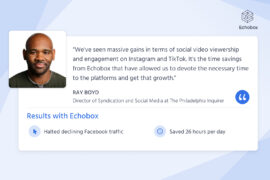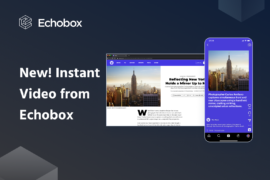This article was originally published on Digital Content Next.
Faced with challenging economic realities, more publishers are looking to artificial intelligence to improve content performance and ensure that each cent invested generates the maximum return. AI can increase ROI in many ways — two stand out for publishers: optimizing decisions at scale using real-time and granular data, thus leading to better performance and yield, and automating tedious, repetitive tasks, thus reducing expenditures of time and cost required for these processes.
There is a perception that only larger publishers can successfully integrate AI and automation, given their greater financial resources to invest in developing and implementing AI systems. But advances in AI technology mean this is no longer the case. Ready-made, third-party AI solutions require far fewer resources and can be implemented within the existing framework of a publisher’s workflow, producing great benefits for publishers of all sizes.
Let’s examine how AI benefits content distribution strategies in particular and outline five ways publishers are incorporating AI to reduce costs and boost ROI.
AI in action
Newsweek adopted automation to save time on curating and sharing content to social media while boosting reach and performance. By integrating artificial intelligence into its workflow, Newsweek saves over 20 hours per week while doubling referral traffic from Facebook.
“It takes a lot of time out of the day to post new content, recycle a ton of content, and everything else you’re supposed to do in an 8-hour workday,” Adam Silvers, Newsweek’s Associate Director of Strategy, explained, highlighting why the team initially turned to automation, and why AI has become indispensable to Newsweek’s workflows: “There’s no question about the benefit.”
Five ways automation can reduce costs for publishers
- Scale and enhance teams’ output at no additional cost: Not all publishers have the resources to dedicate staff to managing and optimizing content distribution. For these small teams, AI can be a cost-effective solution to ensure coverage without additional staff investments. Publishers can automate the entire workflow of distributing content — from selecting content to writing and posting messages at the optimal time — without requiring human involvement. Email — another key distribution channel for publishers — can also benefit heavily from AI, allowing publishers to fully automate the entire process of curating, personalizing, and sending newsletters. Non-profit news outlet San Antonio Report takes advantage of intelligent automation to power its social media presence without a single staff member dedicated to social media, saving on people costs while generating important online engagement with its content.
- Automate to extend coverage without requiring more resources: Large and small newsrooms alike use automation to fill gaps and supplement their existing structures. Publishers such as the South China Morning Post (SCMP) augment their social media teams with automation to save time and cover unsociable hours. With a global audience, SCMP uses automation to ensure 24/7 coverage and remain responsive to trends or stories that break overnight or on the weekend without needing to invest in out-of-hours staff.
- Use AI to maintain referral traffic and revenue despite algorithm changes: Facebook is the most important social media platform for publishers by a long shot. Despite news of slowing user growth, Facebook generates the most traffic for publishers from the largest global audience. Understanding the intricacies of Facebook’s algorithm is therefore vital, especially as the company makes fundamental changes to the way in which content is surfaced. Social media algorithms are constantly changing, from slight tweaks to substantial overhauls. By employing AI technology, publishers can stay responsive to these changes with software that monitors vast datasets to discern patterns and trends. They can react quickly to the findings. Publishers using AI in this way ensure constant and automatic protection against platforms’ algorithm changes that can severely impact referral traffic and, therefore, ad revenue.
- Use AI to extend content’s lifespan and value: Every story requires a significant investment to produce, and AI is helping publishers ensure they extract maximum value from each piece by optimizing reach and exposure. One example comes from social media. Reposting stories on social platforms is a highly cost-effective means of maintaining a robust supply of social content, leveraging a publisher’s archives, and increasing engagement. Our research shows that reposted content offers significant value, gaining an average of 67% of the clicks a piece generated the first time around. But it is more complex than just reposting the best-performing articles. AI constantly calculates the right time to post (an aspect as important as the content itself in generating engagement) and reshares posts automatically, earning additional exposure at no extra cost.
- Use AI to avoid costly guesswork and gain new insights: Understanding your audience is perhaps the single most important element of a social media strategy that drives ROI. AI has a few important uses in this regard. Publishers like Hello! and The Telegraph run A/B tests on Facebook posts, not only to increase performance but, in the case of The Telegraph, to demonstrate the efficacy of certain stylistic choices, such as a shorter headline. AI-powered testing can work hand-in-hand with journalists, editorial and social media staff to generate greater ROI from audience development by automating the process or even suggesting subjects to test based on algorithmic analysis. Publishers are also using AI in a similar way with their email newsletters. AI solutions can run continuous and complex multivariate tests to better optimize emails for individual subscribers, testing everything from the ordering of content to layouts and fonts. In this way, publishers are increasing engagement with their newsletter campaigns — a key aspect of keeping subscription numbers high — without needing to invest more time.
The bottom line
As their cost decreases and use cases multiply, AI solutions will become only more prominent within the industry.
AI technology can fulfill multiple roles: data analyst, social media manager, and audience development manager, to name but a few. By leveraging its power, publishers can generate significant efficiency gains, reduce costs, and free up vital human resources to focus on activities that elaborate their distinct value proposition and ultimately drive ROI.



